Developing an Education Philosophy: Defining Teaching and Learning
VerifiedAdded on 2023/04/21
|6
|1242
|290
Essay
AI Summary
This essay presents an education philosophy centered on critical aspects of teaching and learning. It highlights the importance of cooperation between teachers and learners, emphasizing a bidirectional approach that fosters a collaborative, professional, and safe learning environment. Discipline is underscored as vital for both teachers and learners, creating a respectful and successful classroom. The essay also addresses the significance of understanding students' intellectual abilities, advocating for tailored mentoring and inclusive teaching approaches. The author reflects on their motivations for teaching, aiming to impact students' lives and cultivate their talents, drawing inspiration from a personal role model. The author's career plans involve pursuing advanced degrees in nursing education to become a proficient lecturer and healthcare manager, promoting policies that enhance healthcare education. The paper references scholarly articles to support its arguments.
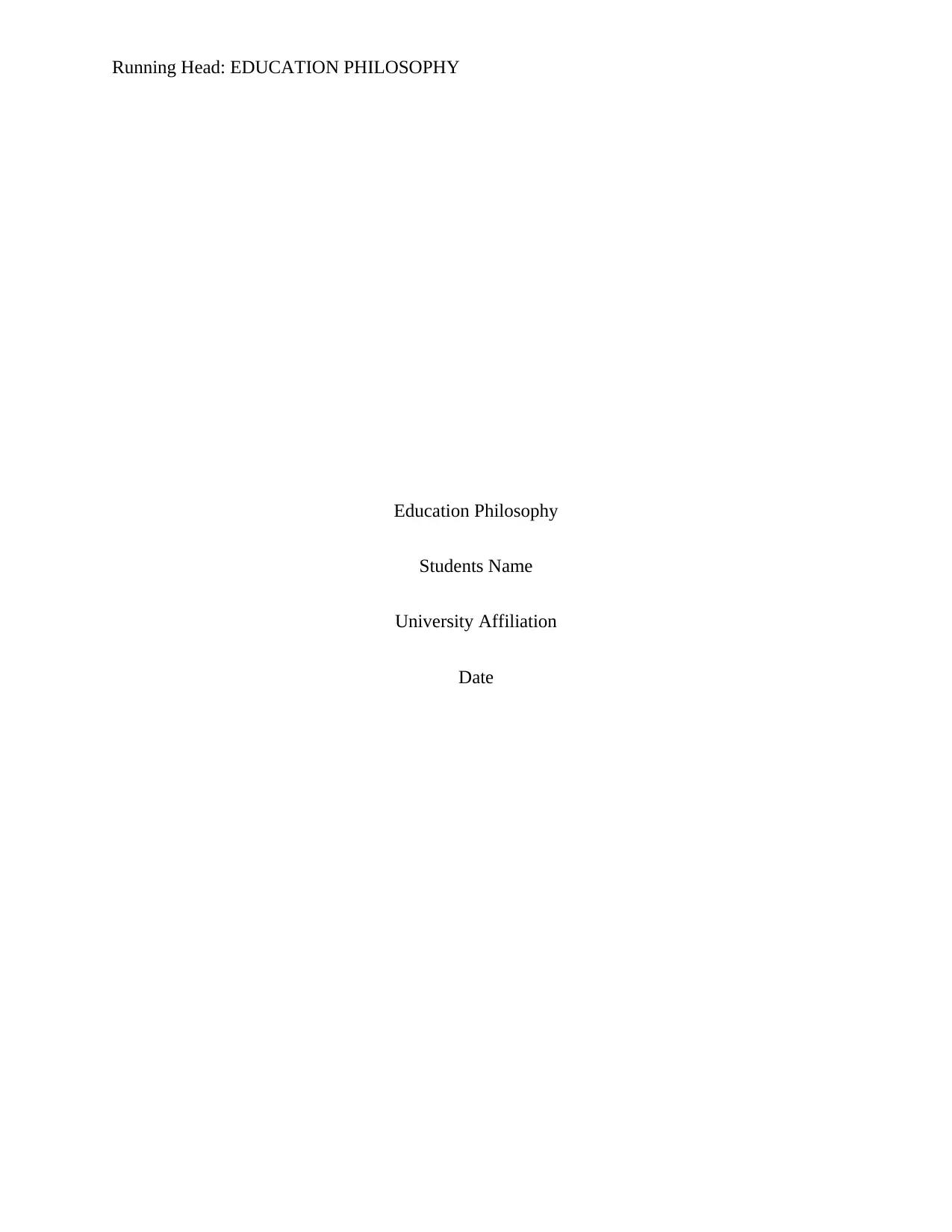
Running Head: EDUCATION PHILOSOPHY
Education Philosophy
Students Name
University Affiliation
Date
Education Philosophy
Students Name
University Affiliation
Date
Paraphrase This Document
Need a fresh take? Get an instant paraphrase of this document with our AI Paraphraser
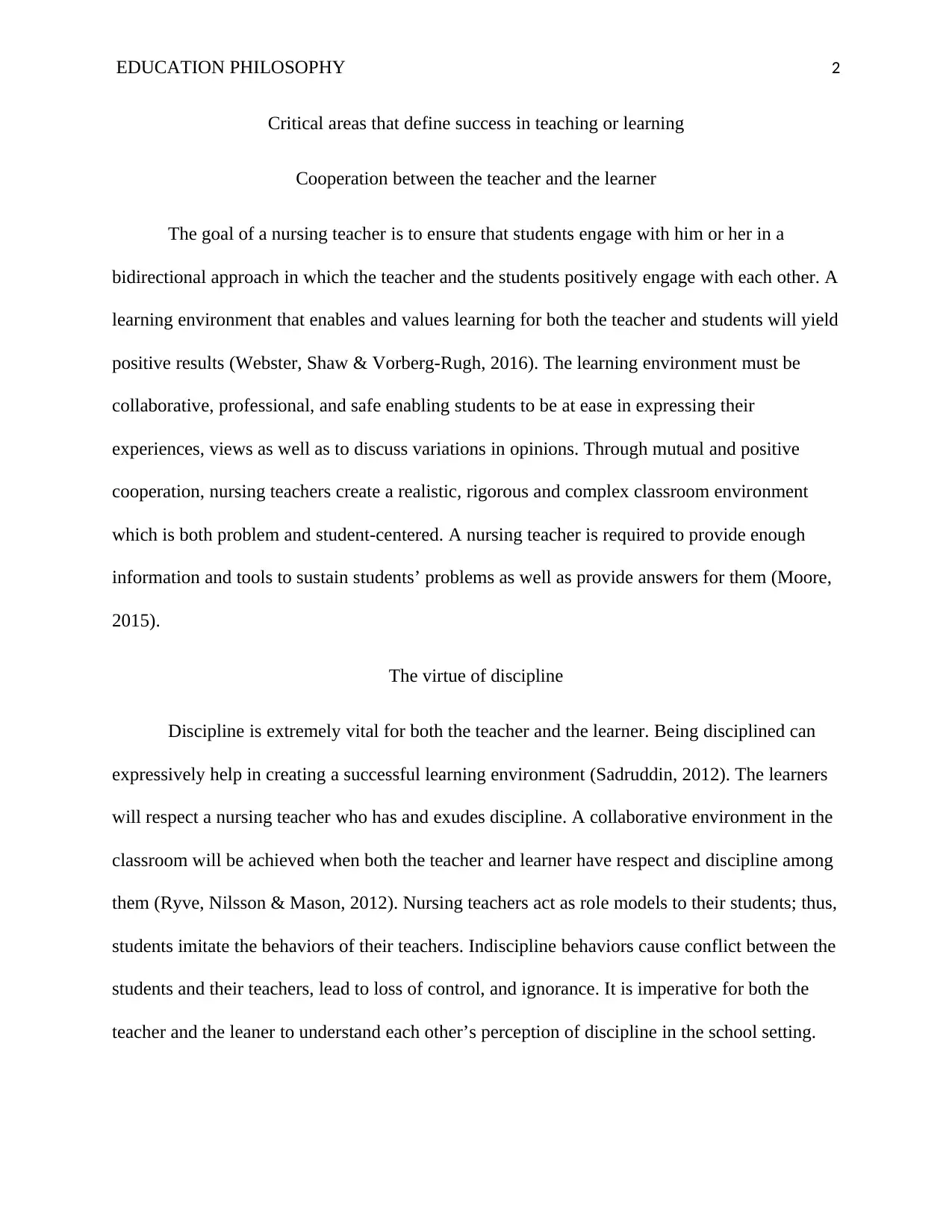
EDUCATION PHILOSOPHY 2
Critical areas that define success in teaching or learning
Cooperation between the teacher and the learner
The goal of a nursing teacher is to ensure that students engage with him or her in a
bidirectional approach in which the teacher and the students positively engage with each other. A
learning environment that enables and values learning for both the teacher and students will yield
positive results (Webster, Shaw & Vorberg-Rugh, 2016). The learning environment must be
collaborative, professional, and safe enabling students to be at ease in expressing their
experiences, views as well as to discuss variations in opinions. Through mutual and positive
cooperation, nursing teachers create a realistic, rigorous and complex classroom environment
which is both problem and student-centered. A nursing teacher is required to provide enough
information and tools to sustain students’ problems as well as provide answers for them (Moore,
2015).
The virtue of discipline
Discipline is extremely vital for both the teacher and the learner. Being disciplined can
expressively help in creating a successful learning environment (Sadruddin, 2012). The learners
will respect a nursing teacher who has and exudes discipline. A collaborative environment in the
classroom will be achieved when both the teacher and learner have respect and discipline among
them (Ryve, Nilsson & Mason, 2012). Nursing teachers act as role models to their students; thus,
students imitate the behaviors of their teachers. Indiscipline behaviors cause conflict between the
students and their teachers, lead to loss of control, and ignorance. It is imperative for both the
teacher and the leaner to understand each other’s perception of discipline in the school setting.
Critical areas that define success in teaching or learning
Cooperation between the teacher and the learner
The goal of a nursing teacher is to ensure that students engage with him or her in a
bidirectional approach in which the teacher and the students positively engage with each other. A
learning environment that enables and values learning for both the teacher and students will yield
positive results (Webster, Shaw & Vorberg-Rugh, 2016). The learning environment must be
collaborative, professional, and safe enabling students to be at ease in expressing their
experiences, views as well as to discuss variations in opinions. Through mutual and positive
cooperation, nursing teachers create a realistic, rigorous and complex classroom environment
which is both problem and student-centered. A nursing teacher is required to provide enough
information and tools to sustain students’ problems as well as provide answers for them (Moore,
2015).
The virtue of discipline
Discipline is extremely vital for both the teacher and the learner. Being disciplined can
expressively help in creating a successful learning environment (Sadruddin, 2012). The learners
will respect a nursing teacher who has and exudes discipline. A collaborative environment in the
classroom will be achieved when both the teacher and learner have respect and discipline among
them (Ryve, Nilsson & Mason, 2012). Nursing teachers act as role models to their students; thus,
students imitate the behaviors of their teachers. Indiscipline behaviors cause conflict between the
students and their teachers, lead to loss of control, and ignorance. It is imperative for both the
teacher and the leaner to understand each other’s perception of discipline in the school setting.
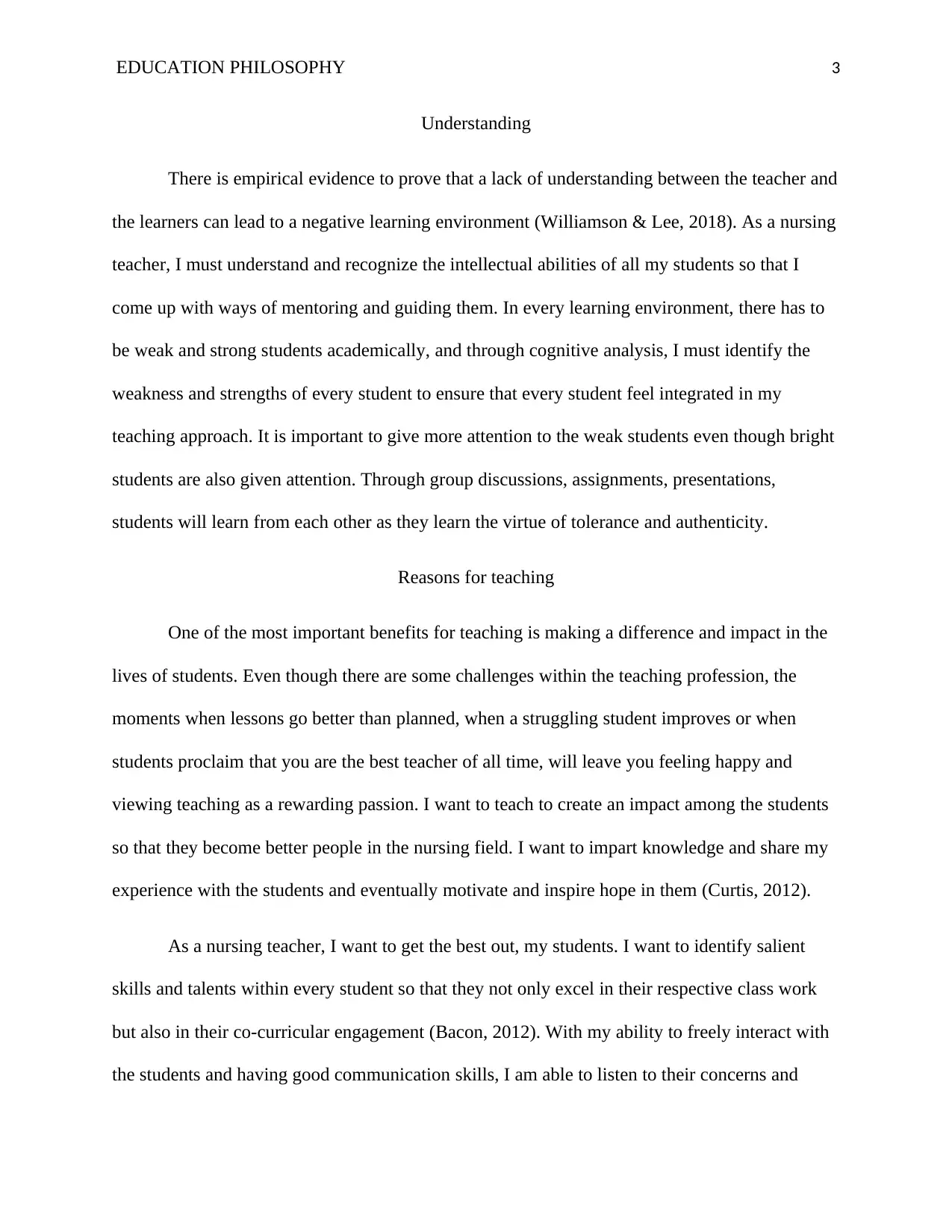
EDUCATION PHILOSOPHY 3
Understanding
There is empirical evidence to prove that a lack of understanding between the teacher and
the learners can lead to a negative learning environment (Williamson & Lee, 2018). As a nursing
teacher, I must understand and recognize the intellectual abilities of all my students so that I
come up with ways of mentoring and guiding them. In every learning environment, there has to
be weak and strong students academically, and through cognitive analysis, I must identify the
weakness and strengths of every student to ensure that every student feel integrated in my
teaching approach. It is important to give more attention to the weak students even though bright
students are also given attention. Through group discussions, assignments, presentations,
students will learn from each other as they learn the virtue of tolerance and authenticity.
Reasons for teaching
One of the most important benefits for teaching is making a difference and impact in the
lives of students. Even though there are some challenges within the teaching profession, the
moments when lessons go better than planned, when a struggling student improves or when
students proclaim that you are the best teacher of all time, will leave you feeling happy and
viewing teaching as a rewarding passion. I want to teach to create an impact among the students
so that they become better people in the nursing field. I want to impart knowledge and share my
experience with the students and eventually motivate and inspire hope in them (Curtis, 2012).
As a nursing teacher, I want to get the best out, my students. I want to identify salient
skills and talents within every student so that they not only excel in their respective class work
but also in their co-curricular engagement (Bacon, 2012). With my ability to freely interact with
the students and having good communication skills, I am able to listen to their concerns and
Understanding
There is empirical evidence to prove that a lack of understanding between the teacher and
the learners can lead to a negative learning environment (Williamson & Lee, 2018). As a nursing
teacher, I must understand and recognize the intellectual abilities of all my students so that I
come up with ways of mentoring and guiding them. In every learning environment, there has to
be weak and strong students academically, and through cognitive analysis, I must identify the
weakness and strengths of every student to ensure that every student feel integrated in my
teaching approach. It is important to give more attention to the weak students even though bright
students are also given attention. Through group discussions, assignments, presentations,
students will learn from each other as they learn the virtue of tolerance and authenticity.
Reasons for teaching
One of the most important benefits for teaching is making a difference and impact in the
lives of students. Even though there are some challenges within the teaching profession, the
moments when lessons go better than planned, when a struggling student improves or when
students proclaim that you are the best teacher of all time, will leave you feeling happy and
viewing teaching as a rewarding passion. I want to teach to create an impact among the students
so that they become better people in the nursing field. I want to impart knowledge and share my
experience with the students and eventually motivate and inspire hope in them (Curtis, 2012).
As a nursing teacher, I want to get the best out, my students. I want to identify salient
skills and talents within every student so that they not only excel in their respective class work
but also in their co-curricular engagement (Bacon, 2012). With my ability to freely interact with
the students and having good communication skills, I am able to listen to their concerns and
⊘ This is a preview!⊘
Do you want full access?
Subscribe today to unlock all pages.

Trusted by 1+ million students worldwide
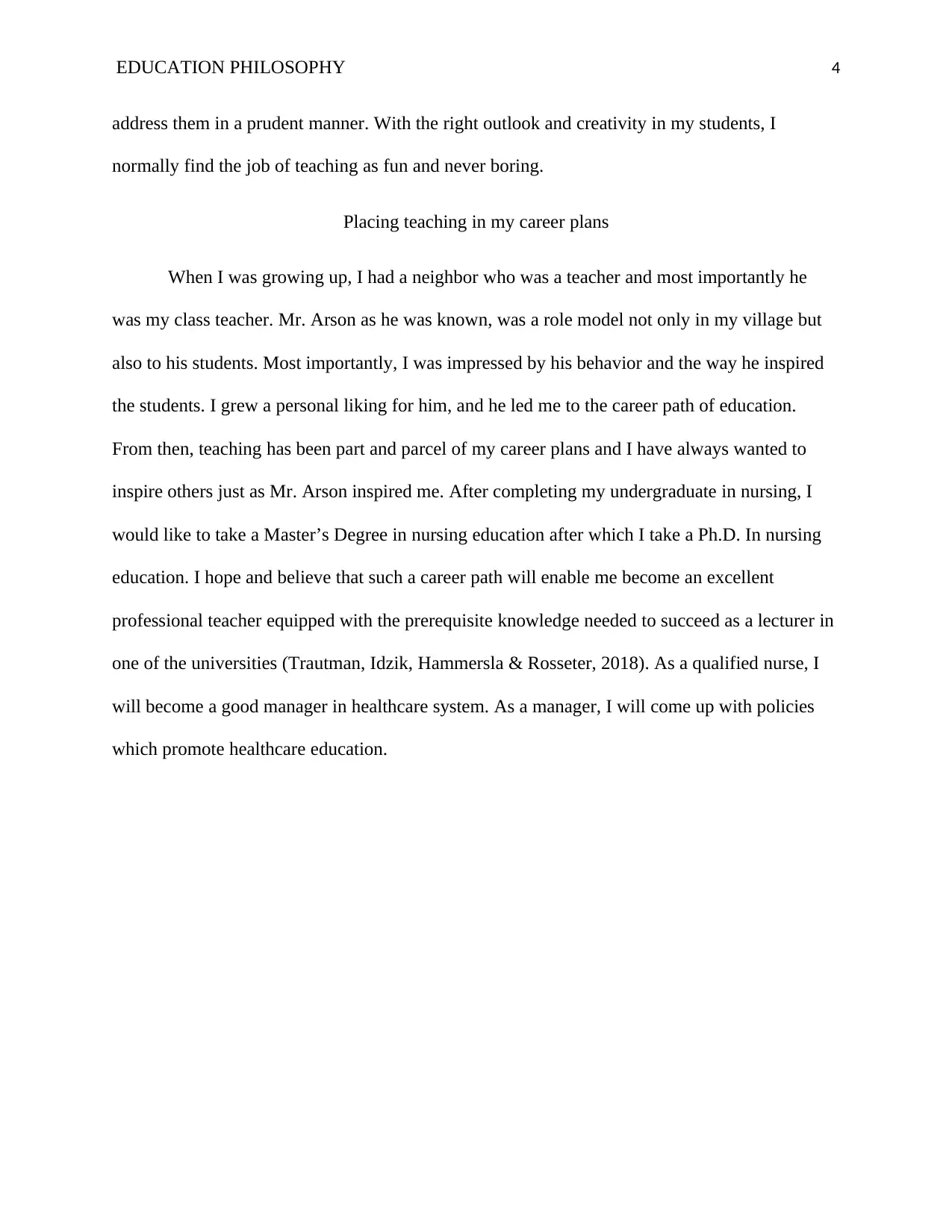
EDUCATION PHILOSOPHY 4
address them in a prudent manner. With the right outlook and creativity in my students, I
normally find the job of teaching as fun and never boring.
Placing teaching in my career plans
When I was growing up, I had a neighbor who was a teacher and most importantly he
was my class teacher. Mr. Arson as he was known, was a role model not only in my village but
also to his students. Most importantly, I was impressed by his behavior and the way he inspired
the students. I grew a personal liking for him, and he led me to the career path of education.
From then, teaching has been part and parcel of my career plans and I have always wanted to
inspire others just as Mr. Arson inspired me. After completing my undergraduate in nursing, I
would like to take a Master’s Degree in nursing education after which I take a Ph.D. In nursing
education. I hope and believe that such a career path will enable me become an excellent
professional teacher equipped with the prerequisite knowledge needed to succeed as a lecturer in
one of the universities (Trautman, Idzik, Hammersla & Rosseter, 2018). As a qualified nurse, I
will become a good manager in healthcare system. As a manager, I will come up with policies
which promote healthcare education.
address them in a prudent manner. With the right outlook and creativity in my students, I
normally find the job of teaching as fun and never boring.
Placing teaching in my career plans
When I was growing up, I had a neighbor who was a teacher and most importantly he
was my class teacher. Mr. Arson as he was known, was a role model not only in my village but
also to his students. Most importantly, I was impressed by his behavior and the way he inspired
the students. I grew a personal liking for him, and he led me to the career path of education.
From then, teaching has been part and parcel of my career plans and I have always wanted to
inspire others just as Mr. Arson inspired me. After completing my undergraduate in nursing, I
would like to take a Master’s Degree in nursing education after which I take a Ph.D. In nursing
education. I hope and believe that such a career path will enable me become an excellent
professional teacher equipped with the prerequisite knowledge needed to succeed as a lecturer in
one of the universities (Trautman, Idzik, Hammersla & Rosseter, 2018). As a qualified nurse, I
will become a good manager in healthcare system. As a manager, I will come up with policies
which promote healthcare education.
Paraphrase This Document
Need a fresh take? Get an instant paraphrase of this document with our AI Paraphraser
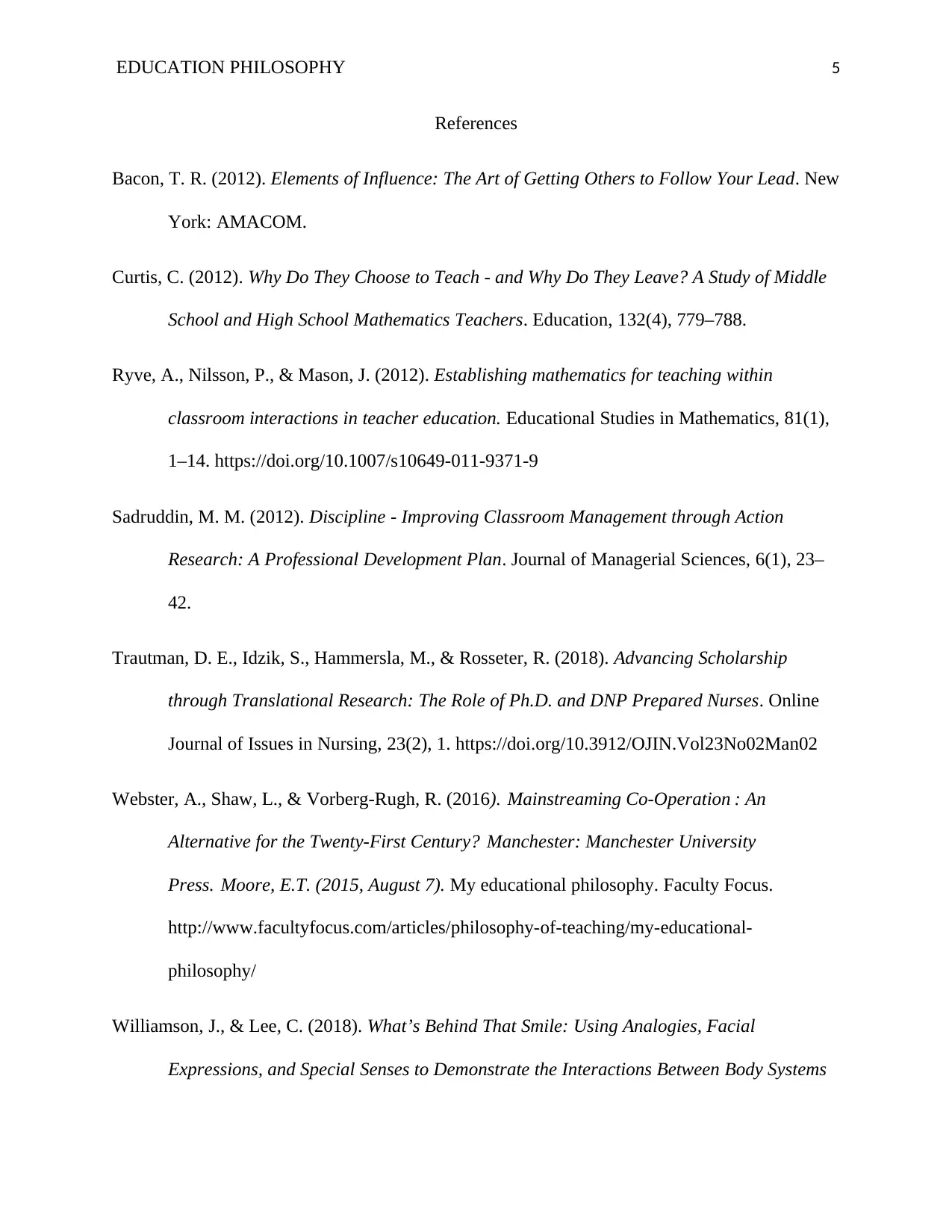
EDUCATION PHILOSOPHY 5
References
Bacon, T. R. (2012). Elements of Influence: The Art of Getting Others to Follow Your Lead. New
York: AMACOM.
Curtis, C. (2012). Why Do They Choose to Teach - and Why Do They Leave? A Study of Middle
School and High School Mathematics Teachers. Education, 132(4), 779–788.
Ryve, A., Nilsson, P., & Mason, J. (2012). Establishing mathematics for teaching within
classroom interactions in teacher education. Educational Studies in Mathematics, 81(1),
1–14. https://doi.org/10.1007/s10649-011-9371-9
Sadruddin, M. M. (2012). Discipline - Improving Classroom Management through Action
Research: A Professional Development Plan. Journal of Managerial Sciences, 6(1), 23–
42.
Trautman, D. E., Idzik, S., Hammersla, M., & Rosseter, R. (2018). Advancing Scholarship
through Translational Research: The Role of Ph.D. and DNP Prepared Nurses. Online
Journal of Issues in Nursing, 23(2), 1. https://doi.org/10.3912/OJIN.Vol23No02Man02
Webster, A., Shaw, L., & Vorberg-Rugh, R. (2016). Mainstreaming Co-Operation : An
Alternative for the Twenty-First Century? Manchester: Manchester University
Press. Moore, E.T. (2015, August 7). My educational philosophy. Faculty Focus.
http://www.facultyfocus.com/articles/philosophy-of-teaching/my-educational-
philosophy/
Williamson, J., & Lee, C. (2018). What’s Behind That Smile: Using Analogies, Facial
Expressions, and Special Senses to Demonstrate the Interactions Between Body Systems
References
Bacon, T. R. (2012). Elements of Influence: The Art of Getting Others to Follow Your Lead. New
York: AMACOM.
Curtis, C. (2012). Why Do They Choose to Teach - and Why Do They Leave? A Study of Middle
School and High School Mathematics Teachers. Education, 132(4), 779–788.
Ryve, A., Nilsson, P., & Mason, J. (2012). Establishing mathematics for teaching within
classroom interactions in teacher education. Educational Studies in Mathematics, 81(1),
1–14. https://doi.org/10.1007/s10649-011-9371-9
Sadruddin, M. M. (2012). Discipline - Improving Classroom Management through Action
Research: A Professional Development Plan. Journal of Managerial Sciences, 6(1), 23–
42.
Trautman, D. E., Idzik, S., Hammersla, M., & Rosseter, R. (2018). Advancing Scholarship
through Translational Research: The Role of Ph.D. and DNP Prepared Nurses. Online
Journal of Issues in Nursing, 23(2), 1. https://doi.org/10.3912/OJIN.Vol23No02Man02
Webster, A., Shaw, L., & Vorberg-Rugh, R. (2016). Mainstreaming Co-Operation : An
Alternative for the Twenty-First Century? Manchester: Manchester University
Press. Moore, E.T. (2015, August 7). My educational philosophy. Faculty Focus.
http://www.facultyfocus.com/articles/philosophy-of-teaching/my-educational-
philosophy/
Williamson, J., & Lee, C. (2018). What’s Behind That Smile: Using Analogies, Facial
Expressions, and Special Senses to Demonstrate the Interactions Between Body Systems
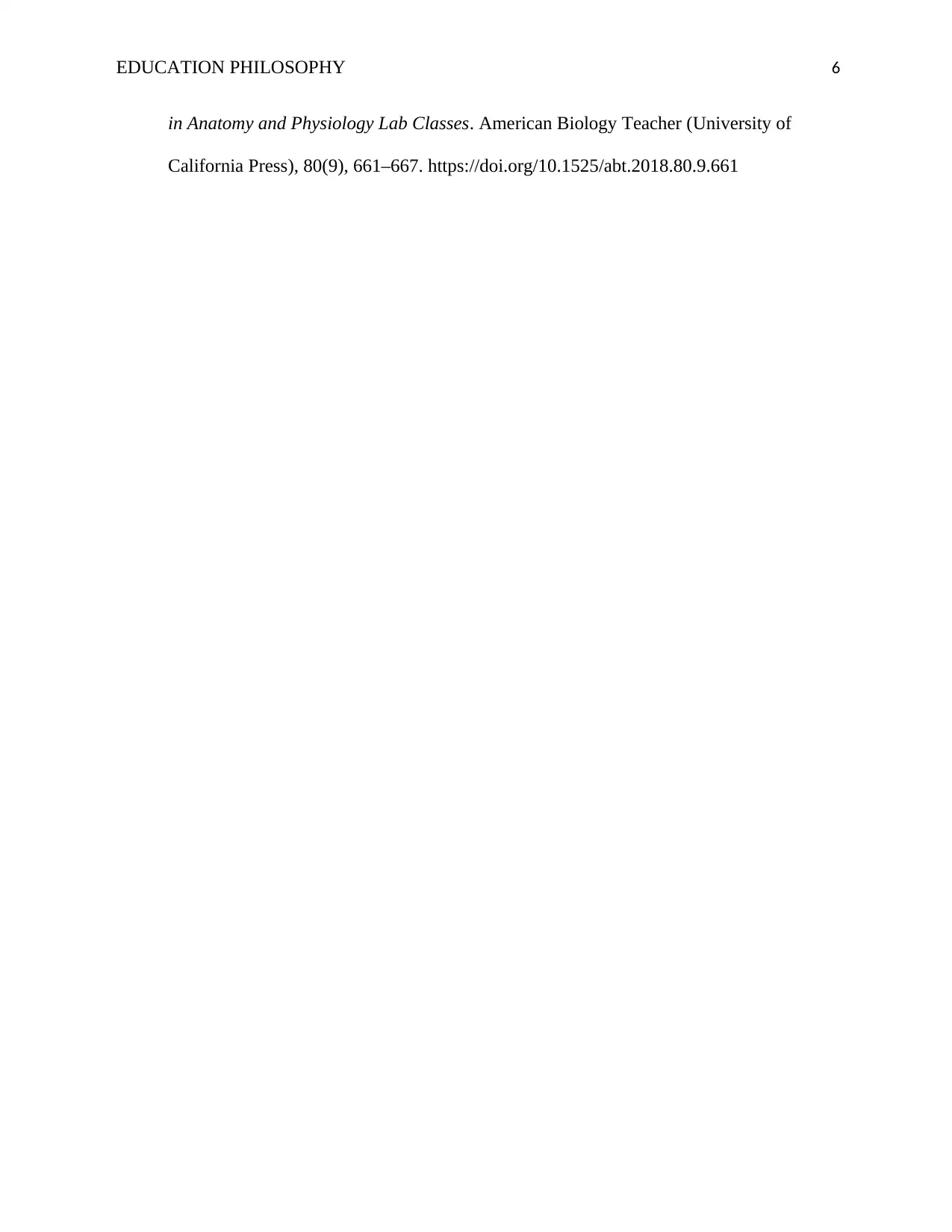
EDUCATION PHILOSOPHY 6
in Anatomy and Physiology Lab Classes. American Biology Teacher (University of
California Press), 80(9), 661–667. https://doi.org/10.1525/abt.2018.80.9.661
in Anatomy and Physiology Lab Classes. American Biology Teacher (University of
California Press), 80(9), 661–667. https://doi.org/10.1525/abt.2018.80.9.661
⊘ This is a preview!⊘
Do you want full access?
Subscribe today to unlock all pages.

Trusted by 1+ million students worldwide
1 out of 6
Related Documents
Your All-in-One AI-Powered Toolkit for Academic Success.
+13062052269
info@desklib.com
Available 24*7 on WhatsApp / Email
![[object Object]](/_next/static/media/star-bottom.7253800d.svg)
Unlock your academic potential
Copyright © 2020–2025 A2Z Services. All Rights Reserved. Developed and managed by ZUCOL.




